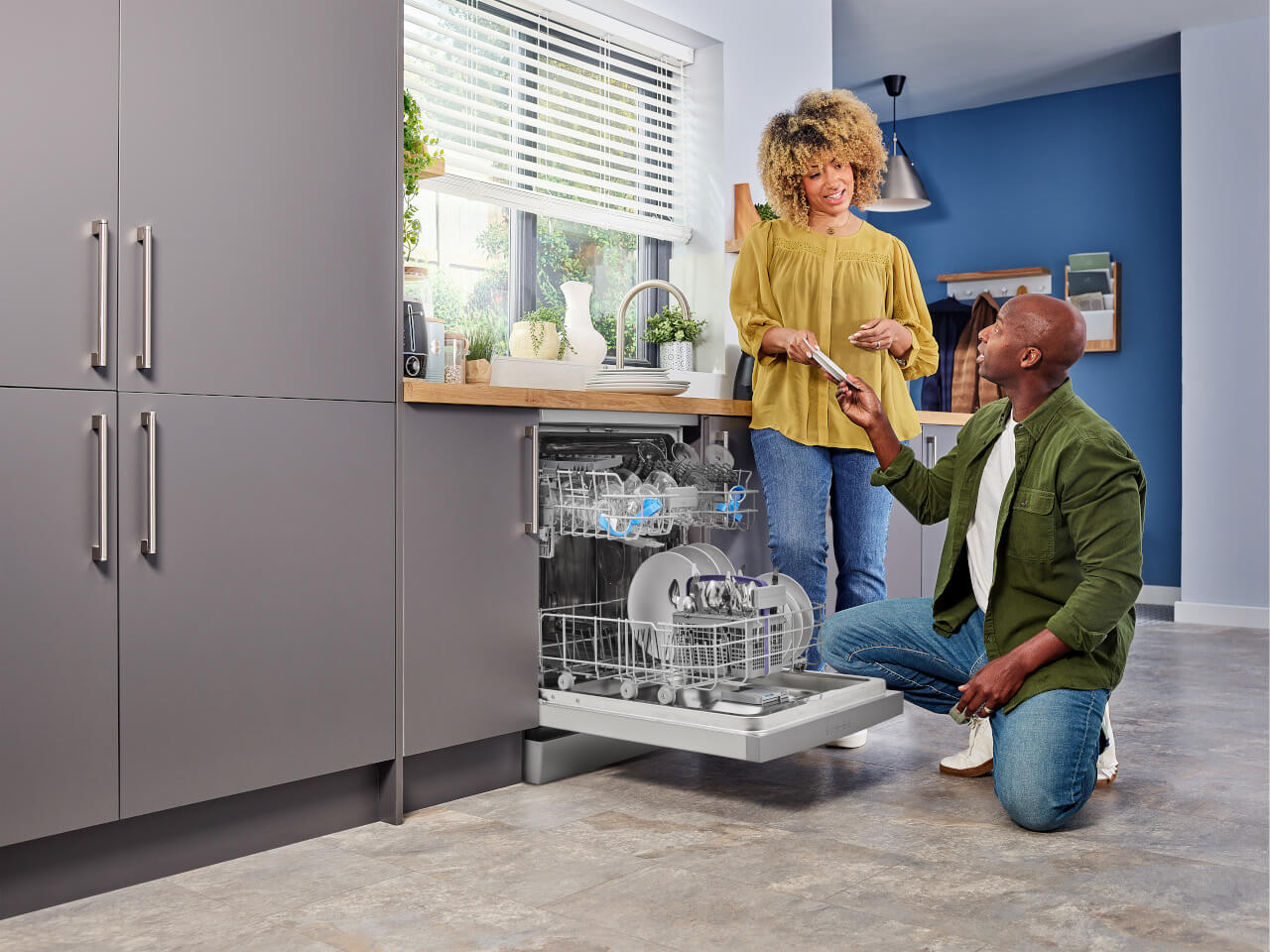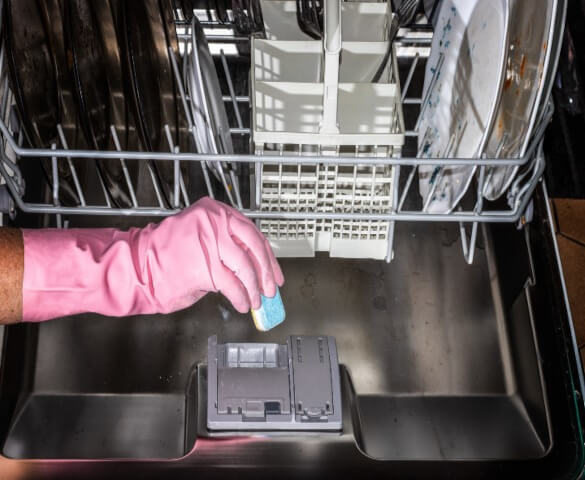How to use a dishwasher?
Dishwashers play a vital role in keeping dishes clean and hygienic. To maximise their efficiency, it's important to understand how to use your appliance correctly. In this useful guide, we've pulled together our top dishwashing tips, helping you to achieve excellent hygiene results at home.

How to load a dishwasher?
Loading the top rack of a dishwasher
The top rack of a dishwasher should be reserved for small, delicate and light items, such as cups, glasses, large silverware/utensils, bowls and dishwasher-safe plastics. When loading the top rack of a dishwasher, it is important to place items upside down as this will prevent water accumulation.
Loading the bottom rack of a dishwasher
The bottom rack of a dishwasher should be reserved for larger items, including plates, large bowls and pans. When loading the bottom rack of a dishwasher, it is important to avoid double-stacking as this can cause water blockages. For more information regarding how to load your dishwasher, please visit our dedicated how to load a dishwasher FAQ.
Using dishwasher detergent
There are three main types of dishwasher detergent that can be used in Beko dishwasher: liquid detergent, dishwashing tablets and powder detergent. Ultimately, the choice of which detergent to use in a dishwasher is subjective and is down to personal preference. To discover more about the different types of dishwasher detergent, please read on.
Liquid dishwashing detergent

The main benefit of using a liquid dishwashing detergent is that the detergent dissolves quickly during the wash cycle. The amount of detergent can also be adjusted depending on the washing load. However, when compared to dishwashing tablets, liquid detergent may have reduced cleaning power and has the potential to spill into the machine, leading to excess suds.
Dishwashing tablets
Dishwashing tablets are easy to use and deliver excellent cleaning and shine performance. During a wash cycle, your dishwashers will release the tablet from the detergent compartment at the optimal time, achieving excellent cleaning results every time. To use a dishwashing tablet, follow the instructions below:
- Place one tablet into the main detergent draw. If necessary, remove any outer packaging before placing the tablet into the draw.
- Close the detergent draw.
- Close the dishwasher and select a wash cycle.
- Run the dishwasher.
If you are finding that your dishwasher tablet is not being dissolved, please read our dedicated why isn't my dishwasher tablet being dissolved guide.

Powder dishwashing detergent

If you are using powder detergent in your dishwasher, there are a number of things you need to consider. Firstly, the settings of your Beko dishwasher will need to be adjusted in the menu for power detergent usage. To do this, hold P+ and the delay buttons for three seconds. Press P+ button until “a1” is shown and turn Auto-Tablet function off. For a more visual guide, please watch the video above or refer to the user manual.
The amount of powder detergent used will vary according to the load of dishes. For a smaller load, one scoop of powder detergent should be used. Alternatively, for a normal load, two scoops of powder detergent will be needed. It is important to always store powder detergent securely, ensuring that the detergent does not get damp and clump together.
Selecting a dishwashing cycle

When using your dishwasher, it is important to select the correct wash programme for your needs. If you are unsure of which programme to run on your Beko dishwasher, watch are our dedicated video to learn which programme will be suitable for your dishes.*
Our range of Beko dishwashers feature a host of helpful programmes designed to help you achieve excellent dishwashing results every time. To check which wash programmes are available on your machine, check the top of your Beko dishwasher. Depending on the model selected, the following programmes may be available on your appliance:
- Mini 30': All dishwasher in our range feature our Mini 30' programme, which can wash a full load of slightly soiled dishes in just 30 minutes, perfect for busy families.
- Quick&Shine: Ideal for when you are short on time, our Quick&Shine programme can wash a full load of dishes in just 58 minutes.
- Intensive 70°C: Our intensive 70 programme reaches a temperature of 70°C, ensuring excellent hygiene results at home and removing even the toughest stains.
- HygieneIntense: For added peace of mind, our HygieneShield dishwashers feature a HygieneIntense programme which uses high temperatures to effective kill more than 99.9% of bacteria and viruses.
*Please note: each Beko dishwasher will feature different wash cycles depending on the model purchased.
Using rinse aid in a dishwasher

To help water rinse off of your dishes and glasses, it is important to regularly fill your machine with rinse aid. To fill your dishwasher with rinse aid, please follow the below instructions:
- Open rinse aid compartment.
- Fill up to the surface and close.
- Turn on dishwasher and check warning light has been removed.
Other dishwasher maintenance
In order to keep your dishwasher working at maximum efficiency, it is important to clean your appliance on a regular basis. In doing so, you can help prolong your dishwasher's lifespan, prevent problems from occurring and keep your appliance smelling fresh. As a general guide, we suggest deeply cleaning your machine every few months to prevent the build-up of limescale, bacteria and odours.
For easy-to follow instructions and videos that explain how to clean your dishwasher, check out our dedicated how to clean a dishwasher guide. Alternatively, if you are experiencing blockage issues with your dishwasher, please read our detailed how to unblock a dishwasher guide. For more information, including detailed video guides, explore our dedicated dishwasher how-to guide.
Did we answer your question?
We are so sorry we were unable to answer your question. You might be able to find the answer you are looking for in the ‘Related Questions’ below. If your query is still unanswered, please head over to our Contact Us page for further assistance.
Search FAQ’s
Search or browse our frequently asked questions to find the answer to your query.



